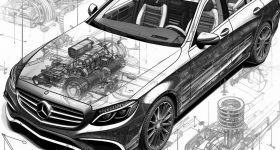The Latest Automotive Technology to Prevent Collisions

Since the 1960s, automotive manufacturers have incorporated cutting-edge technologies into their vehicles to make them safer. Crumple zones, seatbelts, anti-lock brakes, and airbags have all saved countless lives. One of the most notable developments over the last 10 years is computer-assisted collision prevention technology, designed to prevent crashes before they occur.
Car collisions can devastate your vehicle and cause serious injuries, both of which can take a toll on your wallet. For this reason, staying on track of what’s new in automotive technology and how you can use it to your advantage is important.
Autonomous Emergency Braking
High-quality brakes can help prevent collisions. Throughout the years, vehicle companies have improved brake technology tremendously. If a car is equipped with an autonomous emergency braking system, it will automatically apply the brakes to either stop or slow down the vehicle when it detects a possible crash. The system is only activated once the driver fails to push the brakes. Based on the car’s speed, this computer-controlled system activates faster than human speed. This brake technology prevents collisions via an advanced stopping power when it sets in.
Rearview Cameras
Rearview cameras improve the ability of a driver to see bicycle riders, pedestrians, and other vehicles when pulling out of a parking space or driveway. A camera placed at the car’s back activates as the driver reverses. An onboard display enables the driver to see what is behind the car.
The best camera technology also comes with an alert system that warns the driver of any obstacles. The technology started as an optional feature, but in 2018, it became a federal requirement. All motor vehicles that weigh less than 10,000 lbs. must be equipped with rearview monitoring technology.
Traction Control System
Slippery roads after rain and snow are a big contributor to road accidents. This happens when your car loses traction, even at low speeds. The traction control system is an automotive technology that works to overcome this issue by controlling your car’s wheels to prevent spinning when you speed up or start the car. This technology helps reduce the drive torque at each driven wheel.
Electronic Stability Control
The electronic stability control system is designed to help drivers when they oversteer, thereby minimizing the risk of collision. This technology works via brakes on individual wheels and minimizes engine power for additional stability. Different systems in the car work together to facilitate the ESC function.
Lane Departure & Warning Technology
Lane departure warning technology is a collision safety feature that warns drivers when they shift lanes with no turn signal. The cutting-edge technology tries to pull the car back to its original lane to prevent a crash. The lane departure and warning technology on the dashboard alert you about this risky driving style.
LDW technology depends on camera technology to warn the system of any shift between marked lanes. This technology can prevent back-end accidents on busy highways since you have to navigate back to your lane.
Automatic Cruise Control
Cruise control provides the convenience of allowing a driver to set a speed and having the vehicle maintain it automatically throughout the ride. This system introduces a new safety measure by automatically maintaining and monitoring a safe distance between cars. It does this by slowing down the car to prevent it from getting too close to the backside of another car.
Blind Spot Detection
Drivers who fail to monitor the location of other cars before switching lanes are certainly at a higher risk of a collision, but drivers who do the due diligence may still be at risk of an accident due to blind spots. A blind-spot detection system produces an audible warning to the driver and turns on the light on the side view mirror when another car is nearby.
Driver Monitoring Systems
These monitoring systems use algorithms to assess driers and computers to monitor the information to see when someone falls asleep or feels drowsy when driving. The system automatically alerts the drivers so they can pay more attention to the road ahead.
Crash Imminent Braking System
The crash imminent braking system works by slowing down a vehicle automatically when the front crash sensors suspect that impact is imminent. This system makes it virtually impossible for a vehicle to collide and has significantly reduced the number of rear-end collisions. It generally works in combination with a cross-traffic alert system.
When Automotive Technology Causes Accidents
Technology designed to prevent collisions and improve safety may still lead to accidents when systems fail to perform as desired. If you are ever a victim of such a situation, a car accident lawyer will be able to provide you with the right assistance and legal representation. Consult with a reputable lawyer in your area to discuss your options and see what can be done.










